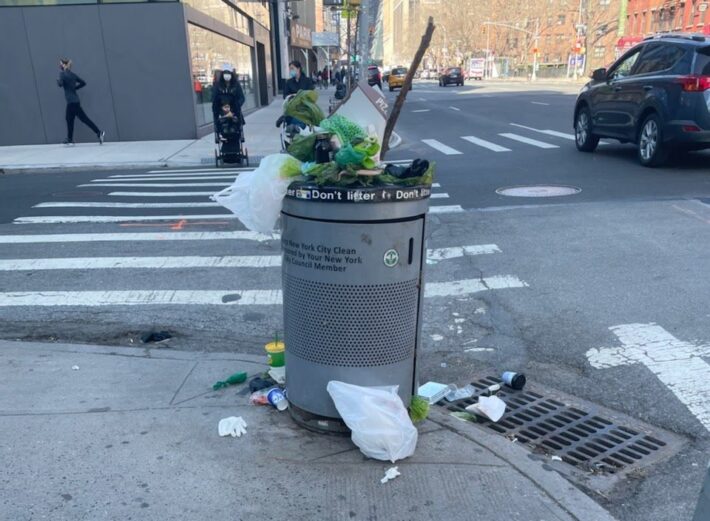
Arthur Tang keeps latex gloves and plastic bags in the downstairs entry to his Chelsea townhouse. Each day, he uses these materials to pick up trash that collects in the dip in his street, which he said is often foul-smelling and soaked in dirty water. It’s not a pleasant task, but if he doesn’t do it, he said no one will.
“I think it’s just a little bit more than a taxpaying citizen should have to do on a regular basis,” said Tang.
Tang has lived in Chelsea since 1979. He said he takes pride in his neighborhood and wants to keep it clean. Plus, he said if he misses a day of cleaning, he’ll get fined. Last year he was fined more than $300 by the city for the trash that collected in the divot in front of his home. However, according to the sanitation department, the area is within his jurisdiction to clean.
“It’s everybody’s responsibility for cleaning 18 inches from their sidewalk and 18 inches into the curb,” said Joshua Goodman, New York Department of Sanitation assistant commissioner of public affairs. “There’s a way to, if he did get a violation, offer that explanation. But I don’t think there’s a way to permanently say, ‘Hey, never fine me because I have this problem on my block.’”
But Tang is not the only resident who’s concerned.
“I’ve been used to this being a clean, safe area, and when that changes, it really upsets you,” said Barbara Harris, a longtime Chelsea resident. “It’s sad to see the garbage overflowing in the streets and on the sidewalks. It was unnerving. Up until a couple of years ago I had not really seen that,” she said.
In September, residents from Tang’s Chelsea neighborhood submitted more dirty sidewalk complaints to citizens’ hotline, 311, than any other neighborhood in Manhattan, New York City open data indicates. Additionally, the total number of sanitation-related complaints in the neighborhood increased more than 20 times last month, as compared to the same time last year, according to 311 data. A Manhattan Community Board 4 survey also ranked sanitation as one of the most important issues in the district. Some residents blame overflowing trash cans by the High Line park entrances as the main source of sidewalk litter, saying the wind blows trash from overflowing cans into their neighborhoods, especially as tourists return to the area.
“The High Line has been a double-edged sword,” said Tang. “It’s a beautiful park, and it’s done a lot for the neighborhood, but it also draws 8.5 million people a year. That’s a lot of trash.”
Contributing to the issue, there is also a shortage of maintenance workers who sweep the streets in front of apartment buildings with more occupants, according to Jesse Bodine, Manhattan Community Board 4 district manager. “Many folks are either still not coming to work, unemployed or working with skeleton crews,” he said.
Tang and Harris both said there need to be more trash pickups for the High Line entrances from West 21st to West 24th Street, which the sanitation department admits are emptied once per day. Though it is possible for the department to increase pickups in each location, Goodman said the composition of the trash should be in focus first.
“If you take your household trash and you walk it down to the garbage can, you’re breaking the law, and that’s when the bags overflow,” said Goodman. He said the department often encounters residents and commercial businesses putting their own trash in the bins, such as waste from restaurants and even Christmas trees in winter. Goodman explained that the department works to combat this with outreach and approaching repeat offenders, along with fines to encourage compliance. Additionally, Goodman said that when a bin is half-filled with trash the can isn’t meant for, simply increasing the number of pickups doesn’t address the issue.
Last year, the Department of Sanitation took a $106 million budget cut, which hindered pickups, but according to Goodman, the normal schedule has been almost entirely restored. “Maybe there was a slower pickup schedule last year, but we feel that we’re back at the level that we were at pre-pandemic,” he said.
There are trash cans by High Line entrances further downtown that get emptied as many as three times per day, but Goodman said in order to increase pickups for the other bins, there would need to be a lengthy approval process.
“It’s not something we’ve identified as one of our ongoing problems,” said Goodman. He encourages residents to submit complaints to 311 about specific overflowing trash cans, instead of general dirty sidewalk complaints that have increased recently in the neighborhood. “We can’t solve what we don’t know about,” he said.
In June, Tang and several other Chelsea residents formed the 500 West Block Association, in hopes of addressing their dirty sidewalk concerns. The group said it has ordered 14 city-approved trash cans for the area, independently paid for by community fundraising and donations. The trash cans are expected to arrive in a few months.
This week, Tang said the dip in his street was unexpectedly paved over due to new construction on 10th Avenue. Additionally, the sanitation department said there are now community improvement workers bagging up overflowing trash in cans on the corners that concerned some in the neighborhood.
Ultimately, the level of community involvement has residents feeling hopeful.
“I think people are taking more pride,” said Harris. “There’s more of an effort now. Because Arthur and that group have formed, they’re going to make sure that this doesn’t happen.”